In order to tackle the problem of worsening congestion in Jakarta, Indonesia’s capital city, the authorities proposed comprehensive improvements, including the development of public transport, road pricing measures and road capacity improvements. Part of these improvements included an area traffic control systems (ATCS), using the Sydney Coordinated Adaptive Traffic System (SCATS) to manage the dynamic timing of signal phases at traffic signals.
The ATCS also uses around 135 Flir TrafiCam vehicle presenc
November 11, 2013
Read time: 2 mins
In order to tackle the problem of worsening congestion in Jakarta, Indonesia’s capital city, the authorities proposed comprehensive improvements, including the development of public transport, road pricing measures and road capacity improvements. Part of these improvements included an area traffic control systems (ATCS), using the Sydney Coordinated Adaptive Traffic System (SCATS) to manage the dynamic timing of signal phases at traffic signals.
The ATCS also uses around 1356778 FLIR TrafiCam vehicle presence sensors and 25 TrafiCam x-stream sensors, installed at some 37 intersections across the city, to feed the SCATS system with reliable video-based traffic information, enabling it to alter the traffic signal frequency at each intersection, improving traffic flows and reducing congestion.
FLIR’s TrafiCam vehicle presence sensor is designed for standalone use, while the TrafiCam x-stream vehicle presence sensor also provides data collection with video streaming.
Both sensors are used for detection and monitoring of moving and stationary vehicles at signalised intersections. Via detection outputs or via IP protocol, vehicle presence information is transmitted to the traffic controller so that signal timing can be adjusted dynamically. TrafiCam x-stream offers streaming video at full frame rate which can be used for system and traffic monitoring in the control room, with a web interface to allow users to manage video sources online.
The ATCS also uses around 135
FLIR’s TrafiCam vehicle presence sensor is designed for standalone use, while the TrafiCam x-stream vehicle presence sensor also provides data collection with video streaming.
Both sensors are used for detection and monitoring of moving and stationary vehicles at signalised intersections. Via detection outputs or via IP protocol, vehicle presence information is transmitted to the traffic controller so that signal timing can be adjusted dynamically. TrafiCam x-stream offers streaming video at full frame rate which can be used for system and traffic monitoring in the control room, with a web interface to allow users to manage video sources online.








